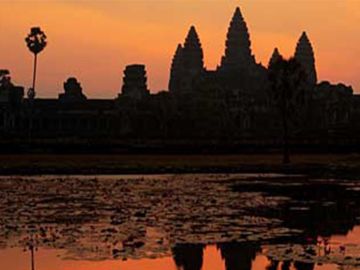By Sasha Reid
The monsoon is due to arrive at any moment and the Tonlé Sap is at its lowest ebb. Our boat scuffs the riverbed sending plumes of mud and silt billowing in its wake. Behind us, Phnom Penh, Cambodia’s present day capital; ahead Siem Reap, gateway to the ancient Khmer capital, Angkor. The journey is advertised as taking five hours, but today it will take twice that long, leaving me plenty of time for sunburn and daydreams.
The year is 2000 and with the spectre of Y2K receding I am about to realise a much-cherished dream in visiting this magnificent temple city. My rose-coloured glasses are firmly in place and I have all the naivety and unbridled enthusiasm of a university graduate let loose on the world. My freshly-minted degree is in Asian Studies, majoring in Southeast Asian history, and I have been voraciously exploring the region to see for myself what has so far only been described or studied in books, lectures, essay-writing and National Geographic Magazine.
On this personal odyssey, Angkor is my Holy Grail, and it does not disappoint. Finally, FINALLY, we arrive in Siem Reap – just in time to head out and get our first glimpse of Angkor Wat set aglow by the fading rays of the day. It’s a thrilling introduction, and the ensuing days of exploration will leave me reeling in wonder at this, the cultural zenith of the Khmer Empire.
From the 9th to the early 15th centuries, Angkor dominated the political landscape of Southeast Asia after Jayavarman II proclaimed himself “god-king” and established an empire that, at its height, stretched from the South China Sea in the east to Burma in the west. The resplendent former Khmer capital is renowned for its architectural masterpieces and also for the ingenious irrigation system of canals and reservoirs that allowed it to harness the wet and dry seasons for economic and social prosperity, supporting a population of almost 1 million people.
At a macro level I had expected to be floored by Angkor’s bold architectural achievements, but what really ended up seducing me were the micro details; the insights into the rhythms of Angkorian daily life revealed by closer inspection of temple bas-reliefs – scenes from the Hindu epic Mahabharata, sensual celestial apsaras, battle victories, royal court life, market scenes, men hunched over a board game, a meal being cooked. Banteay Srei, the Citadel of Women which blushes prettily pink in the afternoon sun, is especially renowned for its delicate, intricate carvings. Pace is crucial here! It’s time well spent that must be offset against the ever-increasing risk of contracting “temple fatigue”. But beyond the awesome majesty of Angkor Wat, the benevolent enigmatic faces of the Bayon, and the strangler figs’ iconic, possessive embrace of Ta Prohm, these are the keys to unlocking Angkor’s inner secrets.
I have revisited Angkor several times in the intervening years since my first most memorable trip. Siem Reap has grown from a sleepy fishing village to the kind of international hotspot glossy magazines like to tout, with its boutique hotels, spas and shopping. The rose-coloured glasses are clearer: around 2 million visitors flock to the area each year so it gets pretty darn crowded, the vendor hustle routine is relentless and the gods apparently have delicately small feet so you’ll find yourself using both hands and feet to scramble up steep ascents to enjoy views from the top.
However, roads have improved dramatically, so overland travel from Phnom Penh by bus is an excellent alternative to rickety boats (if you’re not flying straight into Siem Reap, of course), and lesser-known outlying temples have become more accessible. The ravages of the Khmer Rouge years have left Cambodia a young country where the median age is only 23 years, but the exuberance of youth is resilient. It’s not uncommon to get a wave and a shout from children on their way to or from school two-up on their bicycles, especially if you are on two wheels yourself. The boom in tourism particularly since Angelina Jolie emerged from Ta Prohm in Lara Croft: Tomb Raider (2001) has also brought much needed tourist dollars to the Cambodian economy.
My Angkor ardour has certainly not diminished with time. Cambodia is a nation still rebuilding itself, and its history of great building works puts it in good stead. As for the temples themselves, these vestiges of the great Khmer Empire still harbour mysteries to be unravelled anew with each visit.




